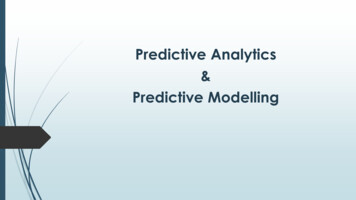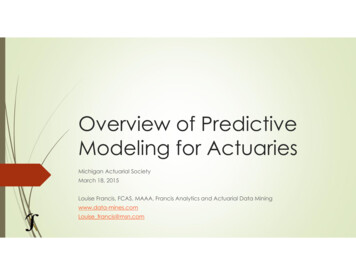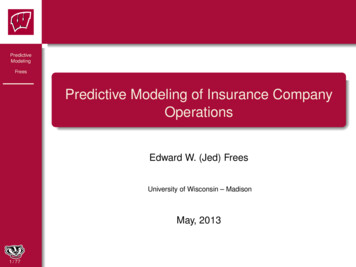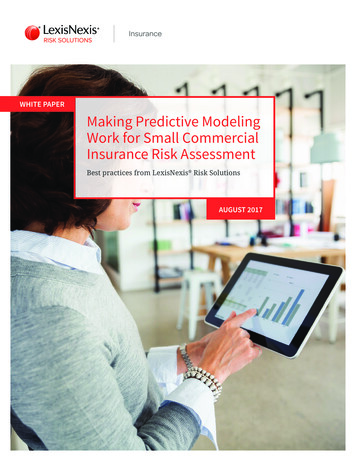
Transcription
AI-BASED PREDICTIVE MODELING FOR SAFETY ASSESSMENT INCONSTRUCTION INDUSTRYA THESIS SUBMITTED TOTHE GRADUATE SCHOOL OF NATURAL AND APPLIED SCIENCESOFMIDDLE EAST TECHNICAL UNIVERSITYBYBILAL UMUT AYHANIN PARTIAL FULFILLMENT OF THE REQUIREMENTSFORTHE DEGREE OF MASTER OF SCIENCEINCIVIL ENGINEERINGDECEMBER 2019
Approval of the thesis:AI-BASED PREDICTIVE MODELING FOR SAFETY ASSESSMENT INCONSTRUCTION INDUSTRYsubmitted by BILAL UMUT AYHAN in partial fulfillment of the requirements forthe degree of Master of Science in Civil Engineering Department, Middle EastTechnical University by,Prof. Dr. Halil KalıpçılarDean, Graduate School of Natural and Applied SciencesProf. Dr. Ahmet TürerHead of Department, Civil EngineeringAssist. Prof. Dr. Onur Behzat TokdemirSupervisor, Civil Engineering, METUExamining Committee Members:Prof. Dr. M. Talat BirgönülCivil Engineering, METUAssist. Prof. Dr. Onur Behzat TokdemirCivil Engineering, METUProf. Dr. İrem Dikmen TokerCivil Engineering, METUProf. Dr. Rıfat SönmezCivil Engineering, METUAssist. Prof. Dr. Gözde BilginCivil Engineering, Başkent UniversityDate: 17.12.2019
I hereby declare that all information in this document has been obtained andpresented in accordance with academic rules and ethical conduct. I also declarethat, as required by these rules and conduct, I have fully cited and referenced allmaterial and results that are not original to this work.Name, Surname: Bilal Umut AyhanSignature:iv
ABSTRACTAI-BASED PREDICTIVE MODELING FOR SAFETY ASSESSMENT INCONSTRUCTION INDUSTRYAyhan, Bilal UmutMaster of Science, Civil EngineeringSupervisor: Assist. Prof. Dr. Onur Behzat TokdemirDecember 2019, 93 pagesThe predictive modeling is a popular research area among the researchers. Most of theproposed models cannot provide a solution for the needs of every contractor as theexisting ones served for only a specific task. Therefore, using these systems becomeinevitably burden on contractors due to its difficulty of use. The thesis aims to providean AI-based safety assessment strategy for every project. The assessment strategyencapsulated the detection of trends in safety failures and corrective actions to preventthem. The study covered two parts. The first part explained a hybrid model of ANNand Fuzzy Set Theory, based on over 17,000 incident cases. The ANN model achievedto forecast 84% incident within 90% confidence, and integrating the fuzzy inferencesystem increased the prediction performance slightly. The second part introduced theuse of LCCA as a Big Data analytics to address the heterogeneity problem. Althoughthe model employed around 5,000 cases for training, the prediction performance wasquite similar to the first part. Besides, this part included a comparison of CBR andANN to reveal which approach demonstrated better compliance with the incident data.Results exhibited the inclusion of big data analytic improved the predictionperformance despite a significant decrease in sample size. The study advanced withthe fatal accident analysis to promote prevention measures. Measures offeredattribute-based corrections by examining the relationships between the attributes.v
Ultimately, the proposed methodology can aid construction industry professionals inanalyzing prospective safety problems using the large-scale collected data during theconstruction.Keywords: Predictive Modeling, Case-Base Reasoning, Artificial Neural Networks,Accident Preventionvi
ÖZİNŞAAT ENDÜSTRİSİNDE GÜVENLİK DEĞERLENDİRMESİ İÇİNYAPAY ZEKA TABANLI TAHMİN MODELİAyhan, Bilal UmutYüksek Lisans, İnşaat MühendisliğiTez Danışmanı: Dr. Öğr. Üyesi Onur Behzat TokdemirAralık 2019, 93 sayfaTahmine dayalı modelleme, araştırmacılar arasında popüler bir tekniktir. Günümüzekadar olan çalışmalarda, kurulan modellerin çoğu, sadece belirli bir amaca hizmetettiğinden dolayı, bazı durumlarda ihtiyaca cevap verememektedir. Dolayısıyla, ilgilimodellerin kullanımı müteahhitler üzerinden kaçınılmaz bir yük haline gelmektedir.Sunulan bu tez ile, her projede uygulanabilecek Yapay Zeka tabanlı güvenlikdeğerlendirme planı geliştirilmesi amaçlanmıştır. Önerilen plan güvenlik ihlalieğilimlerini ve bunların önlenmesi için düzeltici faaliyetlerin ne olduğunu tespitedilmesini kapsamıştır. Çalışma iki bölümden oluşmaktadır. İlk kısım, 17.000'denfazla olaya dayanan, Yapay Sinir Ağları (YSA) ve Bulanık Küme Teorisi hibritmodelinden oluşmaktadır. YSA modeli, kazaların %84’ünü %90 güven ile tahminedebilmektedir. Bulanık mantığa dayalı yorumlama sistemi ise tahmin performansınıaz da olsa arttırmaktadır. İkinci kısımda, veri içerisindeki heterojenlik problemi, ÖrtükSınıf Analizi’nin (ÖSA) büyük veri analitiği yöntemi olarak kullanılması ileçözülmeye çalışılmıştır. Model eğitimi için birinci kısımdaki uygulamanın aksine,5.000 civarında kaza verisi kullanılsa da, elde edilen performans ilk kısma oldukçayakın olmuştur. Ayrıca bu kısım Veri Tabanlı Çıkarımsama (VTÇ) ve YSA tahminmodellerinin karşılaştırmasını da içermektedir. Bu sayede iş kazası verilerine hangimodelin daha iyi uyum sağlayacağı gözlemlenecektir. Sonuçlar, büyük verivii
analitiklerinin dahil edilmesinin veri sayısında önemli bir düşüş olmasına rağmentahmin performansını iyileştirdiğini göstermiştir. Çalışma kaza önlemlerini teşviketmek için ölümcül kaza analizi ile ilerlemiştir. İlgili çalışma, değişkenler arasındakiilişkileri inceleyerek, değişkenlere dayalı kaza önleyici unsurlar sunmaktadır. Sonuçolarak, önerilen çalışma ile inşaat endüstrisi profesyonellerine inşaat sırasındatoplanan büyük ölçekli verileri kullanarak olası güvenlik problemlerini analiz etmedeyardımcı olması amaçlanmaktadır.Anahtar Kelimeler: Tahmine Dayalı Modelleme, Veri Tabanlı Çıkarımsama, YapaySinir Ağları, Kaza önlemeviii
Dedicated to my beloved family ix
ACKNOWLEDGEMENTSI would like to express my gratitude to Asst. Prof. Dr. Onur Behzat Tokdemir for hisvaluable contributions to this study and my life. He always encouraged and supportedme throughout my research.I would like to give my special thanks to my mother, Fatma Deniz Öztürk, and myfather, Mustafa Ayhan, who never give up believing me. They always supported mein every step of my life. I am also very thankful to my sister Başak Nehir Ayhan andmy brother Doğan Erdem Ayhan, who showed their endless motivation and love tome.Finally, I would like to express my appreciation to my beloved wife, Elif Öcüt Ayhan,for her everlasting love and emotional support. She always helps me to overcomeproblems and makes me feel strong at all the time.x
TABLE OF CONTENTSABSTRACT .vÖZ . viiACKNOWLEDGEMENTS .xTABLE OF CONTENTS . xiLIST OF TABLES . xiiiLIST OF FIGURES . xivLIST OF ABBREVIATIONS . xviCHAPTERS1.INTRODUCTION .12.LITERATURE REVIEW .72.1. Safety risk .72.2. Safety management and safety performance .92.3. Studies about big data and data mining in safety .102.4. Artificial Intelligence (AI)-based Predictive Models for Construction Safety103.METHODOLOGY .153.1. Methodology of the first part.153.1.1. Data preparation step with Delphi Method .153.1.2. Development of the prediction model with ANN .193.1.3. Expert module, based on Fuzzy Set Theory .223.2. Methodology of the second part .233.2.1. Latent Class Clustering Analysis (LCCA) .273.2.2. Analytical hierarchical process (AHP) .28xi
3.2.3. Case-based reasoning (CBR). 304.COMPUTATIONAL PROCESS . 334.1. First Part . 334.1.1. Data preparation . 334.1.2. Development of the ANN model and analysis . 364.1.3. Integrating the expert module. 444.2. Second part. 474.2.1. Reducing the size of the dataset by LCCA. 474.2.2. Data modeling . 504.2.3. Development of the ANN model regarding clusters . 504.2.4. Development of the CBR model regarding clusters . 544.2.4.1. Weight calculation by AHP . 544.2.4.2. Calculating the weighted similarity score of test cases . 565.DISCUSSION OF FINDINGS . 636.DEVELOPMENT OF PREVENTATIVE MEASURES . 697.CONCLUSION . 75REFERENCES . 81APPENDIX-A .92APPENDIX-B . 93xii
LIST OF TABLESTABLESTABLE 3.1: Qualifications required for experts (Ayhan & Tokdemir, 2019a).17TABLE 3.2: Experts’ qualifications participated in the Delphi Process (Ayhan &Tokdemir, 2019a) .18TABLE 3.3: AHP Scale (Ayhan & Tokdemir, 2019b) .30TABLE 3.4: Alonso-Lamata RI Values (Ayhan & Tokdemir, 2019b).30TABLE 4.1: Comparison of Questionnaire Statistics between first and second roundin Delphi Process (Ayhan & Tokdemir,2019a) .34TABLE 4.2: The list of attributes obtained by Delphi (Ayhan & Tokdemir, 2019a) 35TABLE 4.3: Target list (Ayhan & Tokdemir, 2019a) .36TABLE 4.4: Network results for training process (Ayhan & Tokdemir, 2019a) .38TABLE 4.5: Linguistic variables and fuzzy numbers (Ayhan & Tokdemir, 2019a) .45TABLE 4.6: The comparison of prediction results after training and testing .46TABLE 4.7: ANN networks (Ayhan & Tokdemir,2019b) .52TABLE 4.8: The weight of Attributes after AHP (Ayhan & Tokdemir, 2019b) .55TABLE 5.1: Comparison of the prediction results of ANN and ANN-Fuzzy for part(Ayhan & Tokdemir, 2019a) .64TABLE 6.1: Preventative actions proposed in the first part (Ayhan & Tokdemir,2019a).70TABLE 6.2: Characteristics of representative fatal incidents (Ayhan & Tokdemir,2019b) .72xiii
LIST OF FIGURESFIGURESFigure 3.1: Flowchart of the data preparation step (Ayhan & Tokdemir, 2019a) . 16Figure 3.2: Flowchart of the prediction step (Ayhan & Tokdemir, 2019a) . 20Figure 3.3: Flowchart of Decision Step (Ayhan & Tokdemir, 2019a) . 22Figure 3.4: Flowchart of the predictive model (Ayhan & Tokdemir, 2019b) . 24Figure 3.5: List of the attributes (Ayhan & Tokdemir, 2019b) . 26Figure 4.1: Error histograms of the best four networks (Ayhan & Tokdemir, 2019a). 39Figure 4.2: Best validation performance of the networks (Ayhan & Tokdemir, 2019a). 40Figure 4.3: Rsq of the four networks (Ayhan & Tokdemir, 2019a) . 41Figure 4.4: MAPE values of 4 networks for training (Ayhan & Tokdemir, 2019a) . 42Figure 4.5: MAPE and Error distribution of test cases (Ayhan & Tokdemir, 2019a). 43Figure 4.6: Demonstration of BIC, AIC, CAIC and Entropy Rsq (Ayhan & Tokdemir,2019b) . 48Figure 4.7 : LCCA Results (Ayhan & Tokdemir, 2019b) . 49Figure 4.8: MAPE values of ANN Network for 758 test cases (Ayhan & Tokdemir,2019b) . 53Figure 4.9: Box and Whisker Plot of Residuals (ANN-758 Test Cases) (Ayhan &Tokdemir, 2019b) . 54Figure 4.10: MATLAB code generated by the author for retrieving data . 57Figure 4.11: Generating the similarity matrixes . 58Figure 4.12: MAPE of CBR for 758 Test cases (Ayhan & Tokdemir, 2019b) . 60Figure 4.13: Box and Whisker Plot of Residuals (CBR-758 Test Cases) (Ayhan &Tokdemir, 2019)) . 61xiv
Figure 5.1: Comparison of CBR and ANN results (Ayhan & Tokdemir, 2019b) .66Figure 6.1: Fatal incident analysis and preventative actions (Ayhan & Tokdemir,2019b .73xv
LIST OF ABBREVIATIONSABBREVIATIONSAHPAnalytical Hierarchical ProcessAIArtificial IntelligenceAICAkaike Information CriterionANNArtificial Neural NetworkARMAssociation Rule MiningBICBayesian Information CriterionCAICConsistent Akaike Information CriterionCBRCase-based ReasoningCIConsistency IndexCRConsistency RatioGAGenetic AlgorithmIOSHInstitution of Occupational Health and SafetyLCCALatent Class Clustering AnalysisMAPEMean Absolute Percentage ErrorMSEMean Square ErrorNEBOSHNational Examination Board in Occupational Health and SafetyOHSOccupational Health and SafetyRIRandom Consistency IndexROFRate of Fatalityxvi
RsqR squareSMSSafety Management SystemsSORSafety Reporting Systemxvii
xviii
CHAPTER 11.INTRODUCTIONThe success of the project activities in the construction projects depends on thecrafting force more than automation, unlike the other industries because of its nature.The existence of crafting leads construction projects to be prone to workplace failures.For this reason, OHS is becoming one of the main pillars of construction projects forsuccessful completion.The construction projects have a significant number of uncertainties inherently, andthe increase in complexity of the project may bring along the crucial problems in everystep of the construction process. The megaprojects referring to long-lasting projectsthat create an enduring value can be an excellent example of the complexity.Healthcare systems and public transportation solutions are one of the megaprojectsexamples regarding their cost as well as scope (Lehtinen et al., 2019; Sergeeva &Zanello, 2018). The cost of the megaprojects is generally more than a million dollars,and they provide the needs and interests of the people for an extended period as well(Flyvbjerg, 2014).However, these projects comprise a wide range of work items (Chong & Low, 2014)that make OHS management critical. The origin of the safety problems relies on thelack of communication between the workers and managers, and the complexity comeswith many managerial conflicts between the stakeholders (Jia et al., 2011). Therefore,the high level of uncertainty exists among the project participants, and it createsparticular problems like safety issues over time.Moreover, the pursuit of completing the projects without delay stimulates the failuresin the physical-mental conditions of the workers. Employers demand extra effort foran increase in productivity, so workers are working in a stressful environment that1
also triggers the accidents. Thus, construction projects are considered as one of themost dangerous working places in many countries due to having still frequent nonfatal and fatal events (Kang et al., 2017; Rubio-Romero et al., 2013).The other cause of safety failures is coming from the problems in adaptation to safetypolicies. The adaptation level of countries to safety policies affects the rate of fatality,especially for companies working in several different regions. There is no viablesystem to predict the safety risk before the start of the project, depending on thecountry, project type, specific project manager, and subcontractors. Taking lessonsfrom previous accidents remains weak due to having no accident analysis systems ina particular project.Some statistics in literature will be given to touch upon the overall position of theconstruction industry in safety. The construction industry has the highest potentialsince the fatality and disabling rate is three times greater than the others (InternationalLabor Organization, 2016). When delving into a deeper in the database of theInternational Labor Organization (2017), the observation rate of the "Day-lost" casesis more than 1.3 million annually, and the rate of the fatality (ROF) was equal to 6 for100,000 workers. According to Zhang et al. (2013), over 26,000 workers diedthroughout the last 20 years. For example, Dong et al. (2013) stated that the fatalityrate still escalated between the years of 2011 and 2012 in the United States, and morethan 900 fatal cases occurred there (Bureau of Labor Statistics, 2016). Besides, almost30% of the fatalities associated with the construction industry, even though theworkforce in construction referred to only 5% of the total in the United Kingdom(Health and Safety Executive, 2014). Likewise, work incidents were over one-third ofall industries throughout the last years in China (Tam et al., 2006; Li & Wang 2004;Liao & Perng 2008).While considering the countries which are on a different level of adaptation to safetypolicies, there is a massive gap between them. Turkey is one of the countries that hasbeen trying to adopt safety requirements. ROF values were calculated for the years2
between 2007 and 2016, and the results were considerably high as 22.35, whereas thisratio was just equal to 6.2 for the manufacturing industry (International LaborOrganization 2017). Turkkan and Pala (2016) also indicated the seriousness of theincrease in a fatality. They underlined that ROF in Turkey sloped to the over 25 from8.6 between the years of 1998 and 2011. Similar to Turkey, the Russian Federationsuffers from construction failures. ROF was equal to 18.0 for the construction industryin Russia (International Labor Organization, 2017).On the contrary, ROF of Sweden and the United Kingdom were considerably belowfrom the countries indicated above, but the construction industry led the others forfatal events (International Labor Organization 2017).The information indicated above shows that the construction industry still requires acomprehensive mechanism to prevent construction accidents (Wu et al., 2010;Hallowell & Gambatese 2009; Hinze et al., 1998; Abdelhamid & Everett, 2000). Atthis point, data collection becomes fundamental elements as most of the problems suchas cost overrun, safety, and quality issues are mainly associated with the inadequatetracking and record-keeping mechanism (Flyvbjerg et al., 2003; Ayhan & Tokdemir,2019a; 2019b). One of the main reasons why accidents cannot be prevented is thataccidents are not kept under records in every aspect. Most of the OHS professionalsdo not give attention to recording "At-risk behavior" and "Near misses" along with theconstruction sites. Instead, they should be promoted to record every detail to developmassive databases, i.e., big data. This data enables professionals to overcome existingand future problems, but the massiveness of it makes the process overwhelminglycomplicated. Therefore, big data bring along its complexity, which makes theunderstanding process of data difficult (Vidal et al., 2015). Big data analytics havebeen applied to the data structure to address the heterogeneity of the data. Someexamples of it can be listed as data mining, data statistics, and machine learningtechniques (Bilal et al., 2016).3
Construction projects, especially for the megaprojects, contain a high number of acomplex process which creates an environment for safety failures. Safety problemsmay incline additional expenses, including healthcare, delays, and penalties (Ayhan& Tokdemir, 2019b). Solutions for safety problems require systematic investigationsof incident characteristics to develop a proactive prevention system that can signifythe sign of risk before. Existing studies are still limited, although researchersintroduced enormous useful models for maintaining safety throughout the workplaces.Most of them fail to exhibit the dynamic nature of the projects appropriately.Moreover, some of the models already developed are not based on factual data. Thatmeans existing models are suffering from utilizing a limited source of cases andattributes.The ultimate goal of this thesis is to prevent construction incidents by developing asystematic safety assessment mechanism that includes the data preparation,prediction, and prevention stages. In this concept, over 18,000 incidents were collectedanonymously from the construction companies. The thesis examined this incident datainto two different stages.The first part comprises the first data preparation stages and the prediction stages. Inthis part, the complete dataset was taken into account, and the list of the attributes wasdetermined. The Delphi technique was applied by the participation of the experts todo so. Later, a hybrid model based on Artificial Neural Network (ANN) and FuzzySet theory was constituted to predict the outcome of the incidents. Naive preventativeactions were introduced in advance. As mentioned before, the big data has itscomplexity inside. That means there exists much more bulk data, which leads toheterogeneity along with the dataset. In the first part, any of the big data analytics wasimplemented; thus, vagueness may result in the prediction outcomes, even the use ofthe Fuzzy Set Theory.In the second stage, the dataset was reduced by taking only incident cases that occurredin the megaprojects. Latent Class Clustering Analysis (LCCA) as big data analytics4
was applied to reach up the same achievement in prediction performance. The new listof attributes was obtained with the help of the previous studies and the experts.Besides, more information is getting into considered accordingly. As well as ANN,Case-based Reasoning (CBR) was getting into the trial for comparison. Lastly, thefatal accident analysis was handled from the fatal accidents that existed in thedatabase, and preventative actions were measured.Ultimately, the present thesis is seeking out how the prediction performance of the AIbased predictive model as well as preventing construction accidents. Besides, theproposed method helps the construction industry professionals to forecast the severityof the incidents by utilizing the data collected and aims to stress the importance ofrecord-keeping by anticipating problems and taking precautions.This thesis was structured as follows. Chapter 2 described the literature review onsafety studies. The content of the literature review fragmented regarding the type ofthe study, and it focused on studies that utilized a predictive model. Chapter 3presented the literature review on the techniques used in this thesis, primarily ANNand CBR, as a predictive model. Besides, the methodology of the research wasintroduced in detail. The construction of a predictive model, data preparation,including data process, were represented. Chapter 4 captured the analysis part andconstituted models were tested regarding their properties. The study advanced withChapter 5, where discussion of results took place. Chapter 6 explained the preventativemeasures determined within the respect of this thesis. Finally, Chapter 7 provided aconclusion of the study and underlined significant findings and discussion as well asthe limitations and future works.5
CHAPTER 22.LITERATURE REVIEWThe seriousness of accidents' outcomes has interested researchers' attention fordecades. They have put a great deal of effort into learning the characteristics ofaccidents by identifying the attributes. Understanding the underlying correlationsamong the trigger attributes of an accident will accommodate a tremendousopportunity to counter work-related safety failures common to construction sites(Winge et al., 2019).Researchers have studied the safety concern in the construction industry under severalpopular topics. Although their focus is to prevent accidents, the methodology of themtends to alternate in each research.The studies have developed many analytical or expert models regarding safetyproblems, but the success of the proposed model depends on perceiving thecorrelations between the attributes.A safety assessment is a comprehensive and well-organized examination of allfeatures of risks to health and safety linked with significant incidents. The literatureinvolves substantial researches that tabulate safety assessment and management. Thefollowing sections involve the studies that concentrate on popular topics among theresearchers.2.1. Safety riskOne of the most common topics on safety concerns is safety risks based onconstruction projects. Gürcanlı and Müngen (2009) assessed the risks thatconstruction workers could confront at the site. They manipulated a hybrid model of7
safety analysis and fuzzy sets to cope with insufficient data. The proposed model mayreveal the significant safety factors and items which play an essential role in enhancingthe safety level of the workplace and workers.Nguyen et al. (2016) presented an analytical model, and they validated their modelwith a case study. The model was integrated with Bayesian networks to capture therisks of working height. Besides, the study provided preventative measures againstfall accidents throughout the sensitivity analysis. Camino Lopez et al. (2008)examined accidents in Spain. They examined the associations between the affectingattributes and discovered how these attributes affect the degree of the severity.Mohaghegh and Mosleh (2009) exercised a Bayesian approach in safety measures torecognize the relationship between organizational factors and safety performance.Therefore, a probabilistic risk assessment was conducted with the inclusion of theregulatory elements that were accepted as principal agencies of incidents.Mohaghegh and Mosleh (2009) tried to recognize the impact of the organizationalfactors on safety performance. They implemented a probabilistic risk assessmentbased on a Bayesian approach, so regulatory elements were considered as principalagencies for incidents. Aminbaskhs et al. (2013) exercised an Analytical HierarchyProcess (AHP) to prioritize the safety risk elements with the help of OHS experts. Thestated system can be practiced as a decision tool that could allow executing therequired safety prevention investment in the budgeting stage. In another study, therelationships between the type of work were associated with the accident types, andcorrelations between them were investigated in detail (Kim et al., 2012).Another safety risk assessment model was proposed to analyze different constructionsite layouts with various safety risk levels (Ning et al., 2018). Studies were conductedto investigate the similarities between the safety and risk perceptions of thestakeholders of construction projects and those of OHS professionals (Zhang et al.2015; Zhao et al. 2016; Liao & Chiang, 2016).8
Moreover, Esmaeili et al. (2015) proposed a model depending on attribute-based riskassessment to estimate the outcome of safety concerning the fundamental attributes.Hallowell and Gambatese (2009) delivered an essential contribution to discoveringthe relative effectiveness of safety program elements. They did a proper safety riskclassification
AI-BASED PREDICTIVE MODELING FOR SAFETY ASSESSMENT IN CONSTRUCTION INDUSTRY submitted by BILAL UMUT AYHAN in partial fulfillment of the requirements for the degree of Master of Science in Civil Engineering Department, Middle East Technical University by, Prof. Dr. Halil Kalıpçılar Dean, Graduate School of Natural and Applied Sciences











